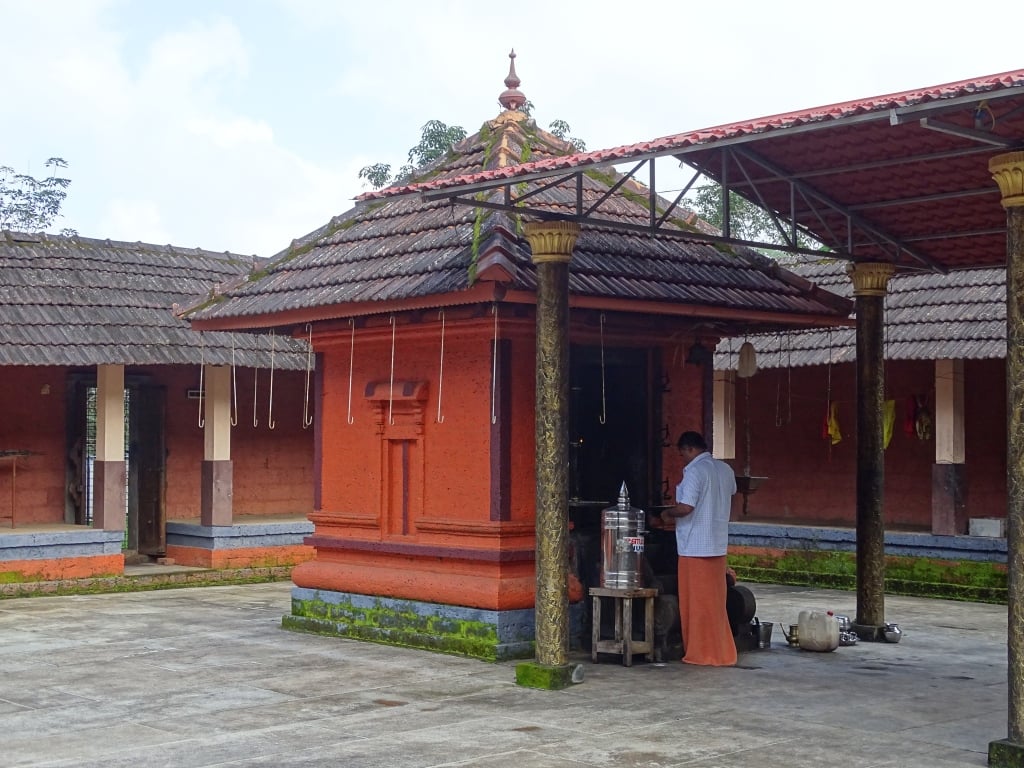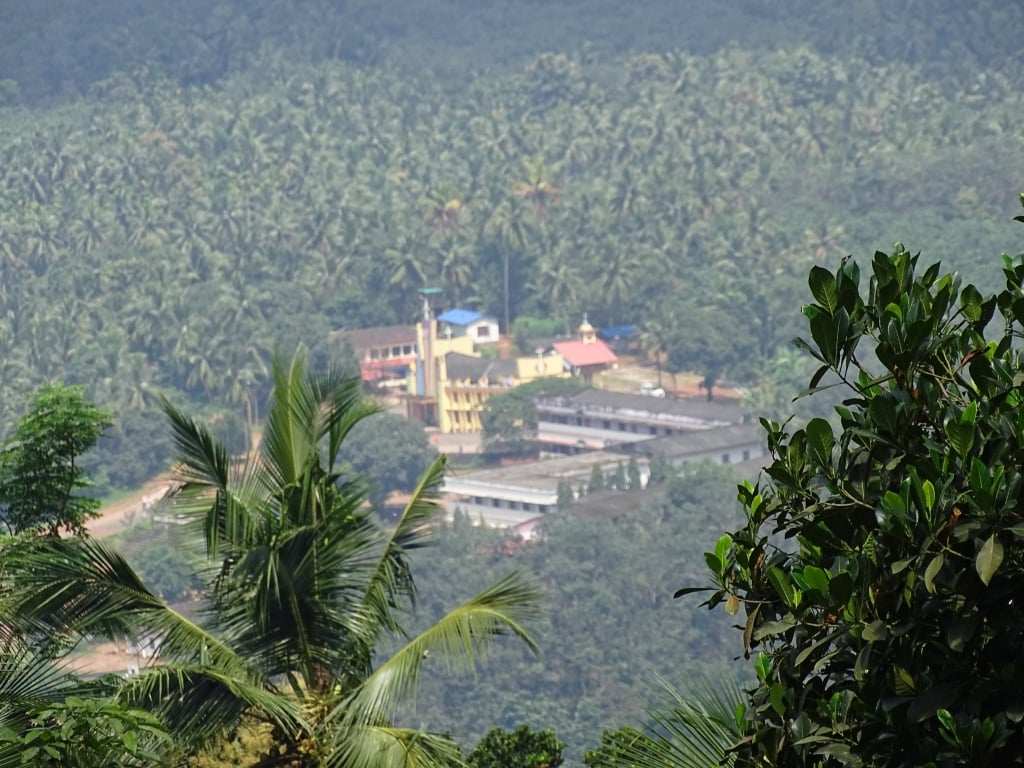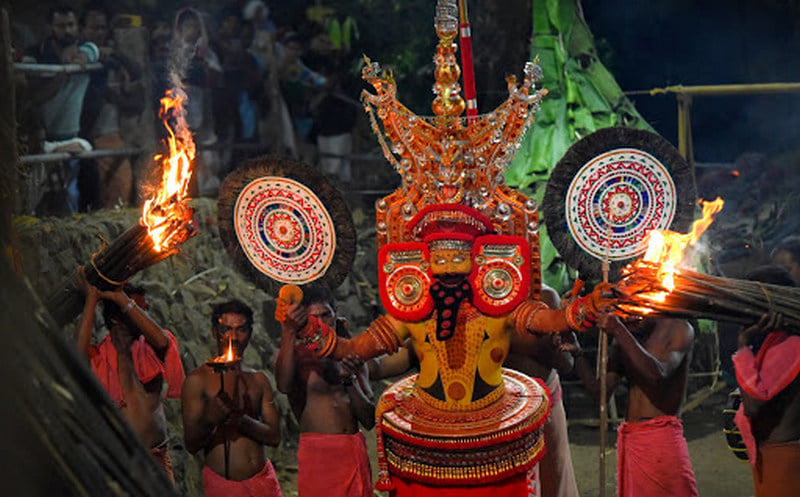Kunnathur Padi is a historically important site dedicated to the folk deity Sree Muthappan. Situated in the Payyavoor Grama Panchayat of Kannur district, Kerala, it lies at an altitude of 3,000 feet above sea level atop Udumbumala in the Sahyadri mountain range.

This region was once part of the Mannanar dynasty's kingdom, the lineage associated with Muthappan. In 1902, Kunhikelapan Mannanar, the last ruler of this dynasty, was killed, and the British administration seized their property. Management of Kunnathur Padi was then handed over to Karakattidam Nayanar, a Nair landlord.
Although there is no temple at Kunnathur Padi, the annual festival for Sree Muthappan is held in this natural setting. It is believed that Muthappan once said, "Fallen leaves, a spring, a large mountain, a round stone, forest, and palm trees are enough for me," reflecting his connection to nature and his preference for simplicity. This forested and mountainous region is now known as Kunnathur Padi. At the summit stands a shrine dedicated to Patikutiyamma.
According to some historians, the commonly held narrative based on Brahmanical history is inaccurate. They assert that this *Arudam* (divine spot) was originally the sacred site of the Mannanar royal family. Prior to their reign, the area was ruled by the ancient Kuttan dynasty, whose seat of power was located on Purali hill.
During the thirty-day-long festival held here, members of the Mannanar lineage observe a strict fast, consuming only thinakkanji (a watery rice gruel).
Only the Mannanar and his consort, Patni McCachiar, are allowed designated seats at the site. All other nobles and attendees must sit on the ground covered with wild leaves, symbolizing humility and equality. The Shanthikars (ritual officiants) at Kunnathur Padi belong to two Thiyya clans bearing the hereditary titles of Mandakurup and Rairukurup. The palace of the Mannanars is also believed to be the birthplace of Muthappan’s grandfather.
During the festival season, a temporary Madappura—also known as the Sreekovil—is erected at the heart of the forest. This sacred spot lies within a serene glade, with a cave nestled amid the woods. To the west of the Madappura stands a distinctive stone, a rock stand, and a mud platform. On either side of the cave, tall palm trees mark the sacred boundary. To the north flows a spring named Thiruvankadavu, and just beyond it lies Aadipadi, another spiritually significant location.
Thanthris perform the essential purification rituals here, which include Sudhi, Pasudanam, Punyaham, Ganapathi Homam, and Bhagavathiseva. The invocation (Malayirakkal) of Sree Muthappan is traditionally carried out by representatives from Puralimala. Interestingly, while Kunnathurpadi is typically the place from where this invocation is performed for other Madappuras, here at Kunnathur Padi itself, Puralimala takes on that role.
Unlike in many other Sree Muthappan centers, Thiruvappana and Vellattam do not manifest simultaneously at the Padi.
Annual festival at Kunnathur Padi spans from the Malayalam month of Dhanu to Makaram (approximately mid-December to mid-January), drawing devotees into the forested hills for a deeply traditional and nature-bound spiritual experience. Sree Muthappan is a revered Hindu deity primarily worshiped in the Kannur district of Kerala, India, regarded as a manifestation of both Lord Shiva and Lord Vishnu, symbolizing the concept of Brahman—the ultimate unity of God as expressed in the Vedas.
Unique among Hindu deities, Muthappan's worship diverges from traditional Brahminical (Sattvic) forms, relying instead on ritual enactments through Theyyam performances by tribal communities rather than idol worship. Fish is a central offering, and the temple practices are inclusive, welcoming people of all castes, religions, and nationalities. Kunnathur Padi, the Aroodam (sacred abode) of Sree Muthappan, is located in Payyavoor village of Taliparamba Taluk, Kannur district, 3,000 feet above sea level atop Udumbamala in the Sahyadri Mountains. There is no permanent temple structure here, as Muthappan himself declared that "fallen leaves, a spring, a large mountain, a round stone, forest and palm trees are enough for me," and thus the annual festival—held from the Malayalam months of Dhanu to Makaram—is conducted in a serene natural setting.
A temporary Madappura or Sreekovil is erected in a forest clearing near a cave, flanked by palm trees, with sacred elements like a stone, a rock stand, a mud platform to the west, and a spring named Thiruvankadavu to the north, beyond which lies Aadipadi. The purifying rituals—Sudhi, Pasudanam, Punyaham, Ganapati Homam, and Bhagavathiseva—are performed by Thanthris, and while Kunnathur Padi is usually responsible for invoking Sri Muthappan (Malayirakkal) at other Madappuras, here the invocation is carried out by Puralimala. The spiritual purity and unspoiled beauty of this sacred site have been preserved for centuries, allowing visitors to experience a profound connection with the divine that transcends material existence.
At Kunnathurpadi, the invoking of Sri Muthappan (*Malayirakkal*) is done from Puralimala, whereas at Puralimala, it is from Kunnathurpadi—a reciprocal tradition. In all other Madappuras , this sacred act is performed with invocations originating from Kunnathurpadi. On the first day of the Kunnathurpadi festival, four Theyyams manifest: Puthiya Sri Muthappan, Puramkala Sri Muthappan, Naduvazhissan Daivam, and Thiruvappana. According to the Vannan community's concept, there are five forms of Sri Muthappan—referred to as *Eiver Muthappan*: Puramkala Sri Muthappan, Puralimala Sri Muthappan (Thiruvappana), Nambala Sri Muthappan (associated with the ant hill and linked to Vellattam), Thoovakkally Sri Muthappan, and Andu Muthappan. As part of the ritual enactments, Muthappan performs Pallivetta (divine hunt) and accepts Veethu (madhu or toddy).
One dramatic act depicts the Lord inscribing Moola Mantras on a granite stone using His arrow, symbolizing sacred knowledge.
A unique feature at Kunnathurpadi is that Thiruvappana and Vellattam do not appear together, unlike in many other Sri Muthappan centers. The divine appearance takes place at night, and after the dance performance, Sri Muthappan sits on the sacred platform and invites Nayanar to sit before Him. The Lord then recites the Pattola, narrating His origin, divine history, and connection with the Vanavar (celestial beings). The Bhandaram (coffer) is brought before Him, and unlike regular offerings, devotees do not place anything directly into it.
Instead, they hand over their offerings to the Lord, who Himself places them into the coffer. This is followed by the most spiritually significant moment—Arulapadu, where Sri Muthappan listens to the devotees' prayers, addresses their grievances, consoles them, and blesses them. Only after this divine interaction does Vellattam appear, marking the continuation of the sacred festivities.
കുന്നത്തൂർ പാടി
മുത്തപ്പന്റെ ആരൂഢമായി കണക്കാക്കപ്പെടുന്ന കുന്നത്തൂർ പാടി കേരളത്തിലെ കണ്ണൂർ ജില്ലയിലായുള്ള പയ്യാവൂർ ഗ്രാമപഞ്ചായത്തിൽ സ്ഥിതിചെയ്യുന്നു. സഹ്യപർവ്വത നിരയിലെ ഉടുമ്പമലയുടെ ഉച്ചിയിൽ, സമുദ്രനിരപ്പിൽ നിന്നും ഏകദേശം 3000 അടി ഉയരത്തിൽ, ഹരിതസൗന്ദര്യത്തിൽ മുങ്ങിയ ആ പ്രദേശമാണ് കുന്നത്തൂർ പാടി. ഇവിടെ മുത്തപ്പന് ക്ഷേത്രമൊന്നുമില്ല; പ്രകൃതിദത്തമായ അന്തരീക്ഷത്തിൽ, മനോഹരമായ ഒരു കാട്, മല, പാറക്കലുകൾ, വസന്തം, പനമരങ്ങൾ എന്നിവയുടെ സാന്നിധ്യത്തിലാണ് ഉത്സവം നടത്തപ്പെടുന്നത്.
"കൊഴിഞ്ഞ ഇല, ഒരു വസന്തം, വലിയൊരു മല, ഉരുളൻ പാറ, കാടും പനമരങ്ങളും മതി എനിക്ക്" എന്ന മുത്തപ്പന്റെ വാക്കുകളാണ് ഈ രീതി രൂപപ്പെടുത്തുന്നതായി വിശ്വാസം.
ഇത് ഒരു കാലത്ത് മുത്തപ്പന്റെ സംവരണമായ മന്നനാർ രാജവംശത്തിന്റെ കീഴിലായിരുന്നതാണ്. 1902-ൽ, ഈ വംശത്തിലെ അവസാന രാജാവായ കുഞ്ഞിക്കേളപ്പൻ മന്നനാർ കൊല്ലപ്പെട്ടതിനു ശേഷം ബ്രിട്ടീഷ് ഭരണകൂടം ആ വംശത്തിന്റെ സ്വത്തുകൾ ഏറ്റെടുത്തതായി ചരിത്രം പറയുന്നു. തുടർന്ന്, മന്നനാരുടെ സാമന്തനായിരുന്ന കരക്കാട്ടിടം നായനർക്കാണ് കുന്നത്തൂർ പാടിയുടെ നടത്തിപ്പിനുള്ള അവകാശം ലഭിച്ചത് എന്നാണ് ചരിത്രരേഖകൾ സൂചിപ്പിക്കുന്നത്.
കുന്നത്തൂർ പാടിയിൽ പ്രത്യേകതയോടെയായാണ് മുത്തപ്പനോടുള്ള ആഘോഷങ്ങൾ നടത്തപ്പെടുന്നത്. മറ്റു മിക്ക മടപ്പുരകളിലും തുലാമാസത്തിലാണ് വെള്ളാട്ടം നടത്തുന്നത് എങ്കിൽ, ഇവിടെ അത് കന്നി മാസത്തിലാണ് നടക്കുന്നത്. പുത്തരി (പുതിയ അരി) വെള്ളാട്ടമാണ് അതിന്റെ പ്രധാന ഭാഗം. കന്നി മാസത്തിലെ നല്ല ദിനം നോക്കിയാണ് വെള്ളാട്ടം നടത്തുന്നത്, ഇത് ഇവിടെ മാത്രം കാണുന്ന ഒരു പ്രത്യേകതയാണ്.
പ്രശസ്തമായ ഉത്സവം ധനുമാസം 2-നാണ് തുടങ്ങുന്നത് (ഡിസംബർ മദ്ധ്യം), ഉത്സവം മകരം 2-ന് (ജനുവരി മദ്ധ്യം) സമാപിക്കുന്നു. ഉത്സവം നടക്കുന്നത് കാട്ടിനു നടുവിലായുള്ള പ്രകൃതിദത്തമായ ഒരു തുറസ്സായ സ്ഥലത്താണ്.
ഇവിടെ ഒരു ഗുഹയും അതിന് ഇരുവശത്ത് രണ്ട് പനമരങ്ങളും കാണാം. ഉത്സവക്കാലത്ത് ഈ സ്ഥലത്ത് താൽക്കാലികമായി ഒരു മടപ്പുര നിർമ്മിക്കപ്പെടുന്നു, അതാണ് ശ്രീകോവിൽ.
മടപ്പുരയുടെ പടിഞ്ഞാറുവശത്ത് ഉരുളൻ കല്ല്, പാറകൊണ്ടുള്ള പീഠം, ചെളിപീഠം എന്നിവയും കാണാം. വടക്കുവശത്ത് “തിരുവങ്കടവ്” എന്ന പേരിലുള്ള ഒരു ശുദ്ധജല ഉറവയുമുണ്ട്. ഈ എല്ലാ ഘടകങ്ങളും ചേർന്ന് കുന്നത്തൂർ പാടിയുടെ ആത്മീയതയും പ്രകൃതിസൗന്ദര്യവും ആഴപ്പെടുത്തുന്നു.
പയ്യാവൂരിലെ എരുവശ്ശി ഗ്രാമത്തിൽ പുരാതനകാലത്ത് അയ്യങ്കര (അഞ്ചരമന) എന്നൊരു രാജവംശത്തിന്റെ അരമനയായിരുന്നു. ഈ രാജവംശത്തിലെ മന്നനാർക്കു സന്താനമുണ്ടായിരുന്നില്ല. ശിവനോടുള്ള പ്രാർത്ഥനയുടെ ഭാഗമായി പല ബലികളും അർപ്പിച്ചു. ഒരുനാൾ, മന്നനാരുടെ ഭർതൃവകാശിയായ പാടിക്കുറ്റിയമ്മ – ഒരു ആത്മവിശ്വാസിയായ ശിവഭക്ത – തിരുവൻകടവ് പുഴക്കടവിൽ കുളിക്കുമ്പോൾ, വട്ടത്തോണിയിൽ ഒഴുകിയെത്തുന്ന ഒരു കുഞ്ഞിനെ കണ്ടു. ഈ ദിവ്യകുഞ്ഞിനെ അവർ ഏറ്റെടുത്തു, വീട്ടിലേക്ക് കൊണ്ടുവന്നു, പാലും പഴവുമൊക്കെ നൽകി വളർത്തി.
കുറച്ചുദിവസങ്ങൾക്കകം, കുട്ടി അവിചാരമായ പെരുമാറ്റങ്ങൾ ആരംഭിച്ചു – കോഴികളെയും മറ്റ് ചെറുപക്ഷികളെയും പിടിച്ച് കൊന്നുകൊണ്ട് വരുന്ന ഈ കുട്ടിയുടെ പെരുമാറ്റം ഇല്ലത്തിന്റെ ശാന്തതയ്ക്ക് ഭംഗം വരുത്തി. അപ്പോൾ അയ്യങ്കര നായനാർ ഇല്ലത്തമ്മയോട് പറഞ്ഞു: "കണ്ടുകിട്ടിയ മകൻ നിമിത്തം ഈ ഇല്ലത്തിൽ നിന്നൂടാത്തെ അവസ്ഥയായല്ലോ വന്നത്."കേക്കാത്തെ മണം വരെ ഞാൻ കേട്ടുതുടങ്ങി... ഇന്നിയിപ്പം ഈ ഇല്ലത്തിത് എങ്ങനെ തുടരാം..." ഇങ്ങനെ പറഞ്ഞതാണത്രെ കുട്ടി. അമ്മ അതുകേട്ടു അതിശയിച്ചു ചോദിച്ചു: "എന്ത് പറഞ്ഞമ്മേ അയ്യങ്കര?" കുട്ടി മറുപടി നൽകി: "ഒന്നും പറഞ്ഞില്ല മോനേ." "അമ്മയോ കേട്ടില്ലെങ്കിൽ ഞാൻ ഒരു ചെവിയാലേ കേട്ടു. ഇനി ഞാനിവിടെ നിൽക്കില്ല, എനിക്ക് മലനാട് വരെ സഞ്ചരിക്കണം," എന്ന് പറഞ്ഞ് ഇല്ലത്ത് നൽകിയ പാലും പഴവുമൊക്കെയും തച്ചുതകർത്തു.
അമ്മ ചോദിച്ചു: "ചങ്ങാതിവേണ്ടേ മോനെ?" അതിന് കുട്ടി പറഞ്ഞു: "നാലോളം ചെന്നാൽ രണ്ടോളം പുലിക്കിടാവ് ചങ്ങാതിയായികിട്ടും." പിന്നെ ആയുധമായി വില്ലും ചുരികെയും എടുത്ത് അദ്ദേഹം മലനാട് ദിശയിലേയ്ക്ക് സഞ്ചരിച്ചു. അന്നാളം തൃക്കണ്ണായിരുന്നുവെന്ന് പറയുന്നു. ആളുകൾ ഭയപ്പെടാതിരിക്കാനായി തൻ്റെ കണ്ണുകൾ പൊയ്ക്കണ്ണ് പോലെ ഒതുക്കി. യാത്രക്കിടെ മൊഴുക്കുവെല്ലി എന്ന സ്ഥലത്തെത്തി, അവിടെ നിലനിന്ന കോട്ടയിൽ നിന്ന് നാലു ദിശയും പരിശോധിച്ചു. അവിടെയാണ് എകർണ്ണൂർ മന, കനകഭൂമി പോലുള്ള കുന്നത്തൂർ പാടിയെ കണ്ടത്. അതിൽ ദൈവികമായ ഒരു ആകർഷണം കണ്ടു, മനസ്സിൽ കൊതിയോടെ അദ്ദേഹം അപ്രകാരം കുന്നത്തൂർ പാടിയിലേക്കു എത്തി.
Address:
Parassinikadavu, Kerala 670563



